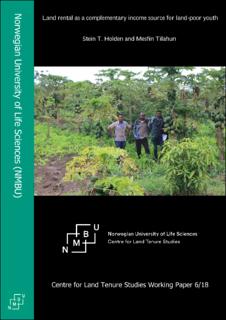| dc.contributor.author | Holden, Stein T. | |
| dc.contributor.author | Tilahun, Mesfin | |
| dc.coverage.spatial | Norway | en_US |
| dc.date.accessioned | 2020-02-18T11:41:20Z | |
| dc.date.available | 2020-02-18T11:41:20Z | |
| dc.date.issued | 2018 | |
| dc.identifier.uri | https://hdl.handle.net/11250/2642245 | |
| dc.description.abstract | Continued high population growth in already densely populated rural areas in parts of Sub-Saharan Africa makes it harder for youth to choose agriculture as their main source of income. We investigate whether near landless youth can still access rented land as a complementary source of income. We utilize a unique data set of rural youth that have been allocated rehabilitated communal land to form formalized business groups for joint business activity. They rely on complementary sources of income and land renting is one of these. Using data from a sample of 1138 youth business group members from 119 youth groups in five districts in the Tigray region of Ethiopia, we find that land renting is a complementary income source for 29% of these youth. It is the most important source of income for 16.8% of the youth and the second most important source of income for 14% of the youth. Access to rented land is constrained, however. Male youth who own oxen and ploughs are much more likely to be able to rent land. Utilizing a trust game to elicit trust and trustworthiness of the youth, we also found a positive association between trust and access to rented land. Trust reduces transaction costs and more trustworthy youth have better access to rented land. The importance of trust is also illustrated by the dominance of kinship contracts and contracts with close neighbors reducing the costs of monitoring tenants. The dominance of sharecropping contracts also contributes to rationing and low allocation efficiency in the market. The prohibition of land sales also limits the potential of the “agricultural ladder” to facilitate youth climbing out of poverty through purchase of land. | en_US |
| dc.language.iso | eng | en_US |
| dc.publisher | Norwegian University of Life Sciences, Ås | en_US |
| dc.relation.ispartofseries | CLTS Working paper;6/18 | |
| dc.rights | Attribution-NonCommercial-NoDerivatives 4.0 Internasjonal | * |
| dc.rights.uri | http://creativecommons.org/licenses/by-nc-nd/4.0/deed.no | * |
| dc.title | Land rental as a complementary income source for land-poor youth | en_US |
| dc.type | Working paper | en_US |
| dc.subject.keyword | Income generation | |
| dc.subject.keyword | Rural areas | |
| dc.subject.keyword | Youth | |
| dc.subject.keyword | Land access | |
| dc.subject.keyword | Trust | |

